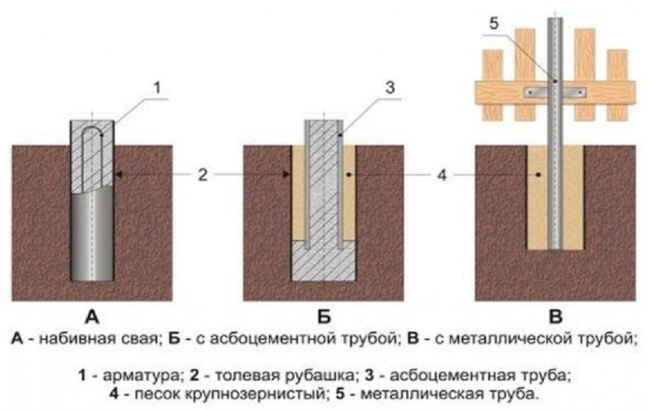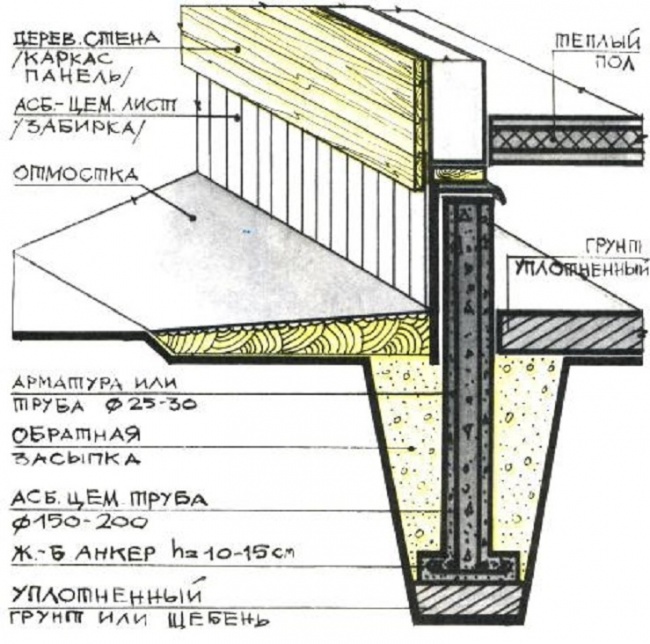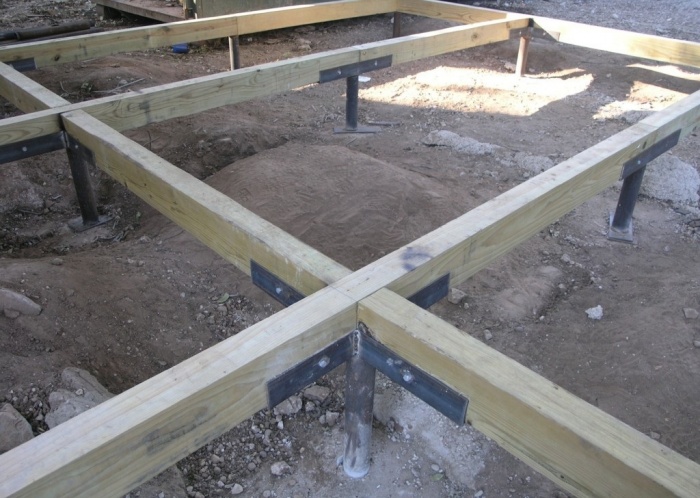Do-it-yourself columnar foundation made of pipes
The laborious process of forming the foundation can be facilitated by resorting to arranging a columnar structure. The conditions for installing pipes as a support and situations where a practical method is unacceptable, we will consider in detail. Studying the features of building a foundation based on pipes made of different materials will allow you to determine the appropriate method.
The nuances of arranging a columnar foundation
The idea to build a columnar foundation of a house from pipes is very attractive from the point of view of practicality. This method is less costly in terms of finance and labor resources, you can do without the involvement of special equipment and work in stages. The use of an economical option is possible subject to the construction of a light building. Among the restrictions on the arrangement of a columnar support structure, there is a difference in height exceeding 2 m, and a problematic geological situation, when there is a risk of displacement of layers.
The depth of the foundation varies depending on the properties of the soil and the total mass of the future structure. Pillars made of pipes must be installed at the same level. This applies not only to the upper part of the supports, but also to the lower edge. The design of the grillage helps to evenly distribute the load on the pipes of the columnar foundation. For wooden houses, a structure made of solid timber is more suitable, at the same time playing the role of a mortgage crown. If the columnar base is installed in an area with a low level of soil freezing as an alternative to a full-fledged strip foundation, the grillage is formed with a slight deepening into the ground.

Characteristic features of a columnar foundation:
- Mandatory pipe installation locations: at the corners of the building, at the points of abutment or intersection of partitions.
- The distance between the supports is 1.0-2.5 m and is calculated based on the results of determining the total mass of the future building.
- The gap between the soil and the high grillage for light structures is 40-80 cm.
- Often flooded soil requires the elevation of the columnar foundation up to 1-2 m above the ground.
- The foundation of a house made of pipes makes it impossible to arrange a basement.
Comment! Areas where additional load is planned (stove or fireplace, porch or terrace) are equipped with local pillars that do not have a bundle with a common grillage.

Design and preparatory work
For a columnar foundation, it is necessary to draw up a project; the following information will be required as the initial parameters:
- the nature of the soil and features of its behavior;
- the level of soil freezing;
- depth of groundwater, the likelihood of floods;
- the amount of precipitation in winter;
- the total mass of the superstructure, which consists of the weight of the material for walls, ceilings, roofs and other additional loads.
Based on the initial data, they determine:
- The depth of the columnar foundation.
- Pipe diameter, which depends on the material used and the design load on the base.
- The number of poles and the frequency of their installation.
Advice! It is advisable to place the supports below the soil freezing line.

The application of the second option is as follows:
- The support is poured with a mixture of concrete by 1/3.
- The pipe is raised by 10-15 cm so that the concrete at the base spreads out, forming a sole for the columnar foundation.
- The important point is that all of the raised legs are the same height. At the same time, the reinforcing frame does not protrude beyond their edges.
- Further, the support is completely filled with concrete, a hairpin is fixed at the top, which rises by 30 cm and serves to connect the pipe and grillage.
Comment! If the soil under the columnar foundation has high flowability, before installing the supports, it is required to arrange a sand and gravel cushion, which must be covered with roofing material.
Preventing premature deterioration of reinforcing bars due to corrosion can help protect them with protective compounds.

Support structure made of plastic
As in the previous version, the process begins with leveling and marking the construction site. The work is carried out using pegs and thread or rope.
The main stages of the formation of a columnar foundation using sewer pipes:
- A trench is dug along the perimeter, in which the points for setting the supports are marked.
- The weight of the future structure and the characteristics of the soil determine the interval between the posts, which should not exceed 2 m.
- Before installing the plastic pipe, a gravel and sand cushion is made at the bottom of the well. The function of waterproofing is performed by polyethylene or roofing material.
- The recess is filled with a concrete mixture and left for an hour for the mortar to set.
- After the allotted period of time, a plastic pipe is being installed, which is pressed in until it stops.
- Further inside the pillar, reinforcing rods are installed, which protrude 20-25 cm beyond the edges.
The setting period of concrete in a columnar foundation lasts 6-8 days, depending on the ambient temperature.

Features of the use of metal pipes
The formation of an iron columnar structure also has two options. In the first case, the installation of supports is carried out 50 cm below the level of the drilled well. It is not important to choose a metal pillar with a diameter of 20-25 cm; you can install two or three supports of smaller thickness. In this case, the gap between the pipes is up to 5 cm.
Important! This method involves the formation of a grillage using a steel profile that is welded to the pipe.
The proposed algorithm for arranging a columnar foundation is characterized by high reliability of fixation and provides the structure with maximum strength.
The second method requires the preliminary formation of a drainage cushion based on sand and gravel. The diameter of the pillars is 15-20 cm. Since the metal support must adhere tightly to the borehole walls, during drilling its base is reduced by several millimeters. The next stage is filling the pipe with a solution of cement and sand. If the construction is planned above one floor, there is a need for additional reinforcement of the columnar foundation with a reinforcing cage.
After five days, after the concrete has hardened, they proceed to the formation of the grillage. It can be made of wood, metal profile or in the form of a strip foundation. The choice depends on the severity of the entire structure.

Conclusion
Column foundation is a reliable supporting structure for light structures. With an increase in the weight of the building, additional reinforcement measures should be provided in order to ensure strength.



